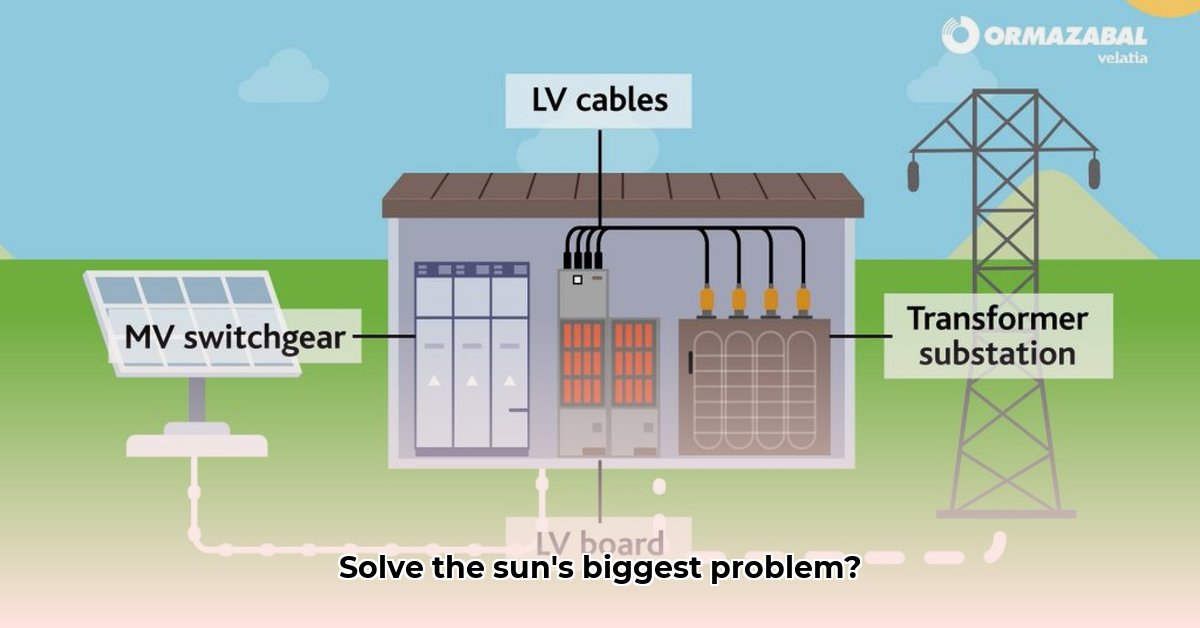So you’ve embraced solar power – fantastic! But what happens when the sun takes a break? That’s where energy storage steps in. This comprehensive guide breaks down the world of solar batteries, from the basics to the cutting-edge technology. We will explore cost comparisons, delve into the pros and cons of various systems, and provide guidance to determine the perfect fit for homeowners, businesses, and individuals curious about maximizing their solar panel investments. Cutting through the technical jargon, we share practical tips, helping you make well-informed decisions about storing solar energy and contributing to a more sustainable future. For more in-depth information on solar energy storage, check out this helpful guide: Learn more.
Can Solar Energy Be Stored? Reliable Energy Storage Solutions
Harnessing the sun’s energy is remarkable, but what happens when sunlight fades? This is where storing solar energy becomes crucial—the key to truly reliable solar power, providing energy even without direct sunlight. So, how effective is solar energy storage? The answer is a definite yes, marking a growing field with many advancements. How can you leverage these reliable energy storage solutions?
Batteries: The Current Workhorse for Renewable Energy Integration
Currently, lithium-ion batteries reign supreme as the most common residential solar energy storage solution. They function as large, rechargeable power banks, offering reasonable efficiency and reliability while becoming increasingly affordable. They do have limitations: their lifespan is finite, and their production carries environmental implications that necessitate consideration. Scientists are continuously innovating to enhance battery chemistry and prolong battery longevity. Did you know that advancements in battery technology could increase energy storage capacity by up to 30% in the next five years? Beyond individual homes, community-scale battery storage is emerging, allowing neighborhoods to share stored solar power, enhancing grid stability and resilience.
Beyond Batteries: Innovative Energy Storage Alternatives
While batteries dominate the home solar landscape, larger-scale projects powering neighborhoods or entire cities demand alternative solutions. Here are a few options for these innovative energy storage alternatives:
-
Pumped Hydro Storage: A simple and established method. Excess solar energy pumps water uphill into a reservoir. When energy is needed, the water flows downhill, spinning turbines and generating electricity. It’s essentially a large, gravity-powered battery! However, the geography must have hills and valleys. The world’s largest pumped hydro storage facility, the Bath County Pumped Storage Station in Virginia, boasts a capacity of over 3,000 MW.
-
Thermal Storage: Solar energy is stored as heat using materials that retain heat for extended periods, such as molten salts or specialized rocks. Later, this stored heat can generate electricity. It’s one of the innovative energy storage alternatives that holds promise for large-scale storage but requires substantial space. Solar thermal power plants with molten salt storage can generate electricity even at night or on cloudy days, extending their operational hours and increasing their reliability.
-
Compressed Air Energy Storage (CAES): This approach uses surplus solar power to compress air into a large container, often an underground cavern or depleted natural gas field. Releasing the compressed air drives turbines to generate electricity. This can store vast amounts of energy, but efficiency improvements remain a key focus. The McIntosh CAES facility in Alabama, one of the few operational CAES plants in the world, has a capacity of 110 MW.
Each method presents its advantages and disadvantages. Pumped hydro is dependable but location-dependent. Thermal storage can hold significant energy but demands considerable space. CAES provides substantial storage potential, but improving efficiency is a primary challenge. Other emerging technologies include liquid air energy storage (LAES) and hydrogen production via electrolysis, offering additional pathways to store renewable energy.
The Economics of Solar Energy Storage: Is it Worth the Investment?
The cost-effectiveness of storing solar energy is a major consideration. Local net metering policies (allowing you to sell excess solar power back to the power company, offsetting costs) and electricity rates significantly affect the economics. Time-of-use (TOU) rates, where electricity prices vary throughout the day, also make battery storage more appealing by allowing you to use stored solar during peak, expensive hours. Currently, the average cost of a home solar battery system ranges from $7,000 to $18,000 installed, depending on battery capacity, brand, and installation complexity. The federal Investment Tax Credit (ITC) can offset 30% of the cost of solar and storage systems, further improving the economic viability.
Specialized software can estimate potential savings by factoring in your home’s energy use, local regulations, and the specific solar energy system selected. Seek professional advice to gain accurate simulations of long-term system performance and design an effective, affordable system. Look for installers certified by organizations like the North American Board of Certified Energy Practitioners (NABCEP) to ensure quality and expertise.
The Future of Solar Storage: Emerging Technologies
The future of solar energy storage is bright! Advances in battery technology are continuously improving energy density, lifespan, and safety. Solid-state batteries, for example, hold the potential to reduce the environmental impact relative to lithium-ion batteries, with increased energy density and improved safety characteristics, as they eliminate the flammable liquid electrolyte found in traditional lithium-ion batteries. Research into flow batteries, which use liquid electrolytes to store energy, and advanced thermal storage continues, promising longer lifespans and greater scalability. In the future, expect to see a blend of these technologies, each catering to different purposes and levels of energy demand. Power-to-gas technology, which converts excess electricity into hydrogen for storage and later use, is also gaining traction as a potential solution for long-duration energy storage.
Getting Involved: A Guide for Stakeholders
Here’s a simple guide for various stakeholders to engage with solar energy storage:
| Stakeholder | Short-Term Actions | Long-Term Actions |
|---|---|---|
| Homeowners | Research lithium-ion battery options; check local net metering policies. | Monitor advancements in battery technology; plan potential system upgrades. |
| Businesses | Explore thermal or mechanical storage options; analyze energy needs. | Invest in research and development; consider hybrid storage systems. |
| Utilities | Integrate grid-scale battery systems; improve grid infrastructure. | Develop infrastructure to support diverse storage technologies; optimize grid management. |
| Governments/Policymakers | Offer incentives for storage adoption; streamline permitting processes. | Fund research; develop comprehensive national energy strategies; encourage innovation. |
| Researchers | Focus on improving battery chemistries and finding cheaper materials. | Work on cutting-edge storage system using new concepts, like gravity batteries and fuel cells |
So, can solar energy be stored? Absolutely! Despite existing challenges, ongoing technological advancements are making a sustainable and reliable energy future increasingly viable. As research advances and technology evolves, the options for storing solar energy will only continue to increase, and it will play a more significant role in a global power grid increasingly powered by renewable sources.
How to Compare Different Solar Battery Chemistries for Home Use and Optimize Your Investment
Choosing the right battery for your home solar system is a critical decision impacting lifespan, efficiency, and overall cost. So, how to compare different solar battery chemistries for home use effectively? Let’s explore the key options.
Lead-Acid Batteries: An Economical But Dated Solution
Lead-acid batteries have a long history, are easily accessible, and are less expensive upfront. However, they have lower energy density, making them bulkier. Plus, they have shorter lifespans than other options, require more maintenance, and raise environmental concerns due to lead’s toxicity. Recycling is essential but increases long-term costs. Do you know that lead-acid batteries typically last only 3-5 years compared to the 10-15 year lifespan of lithium-ion options? Flooded lead-acid batteries require regular watering to maintain electrolyte levels, while sealed lead-acid batteries offer a maintenance-free option but typically have a shorter lifespan.
Lithium-ion Batteries: A Modern, High-Performance Option
Lithium-ion batteries lead in performance. They offer higher energy density, translating to more compact and efficient storage. With a longer lifespan and lower maintenance, they provide a good long-term investment. Lithium Iron Phosphate (LFP) stands out within lithium-ion, offering exceptional safety, even with the potential for thermal runaway that’s concerning with other lithium-ion types. “LFP batteries are becoming increasingly popular for home energy storage due to their enhanced safety and longer lifespan,” said Dr. Emily Carter, Professor of Sustainable Energy at Princeton University. Nickel Manganese Cobalt (NMC) batteries offer high energy density but have slightly lower thermal stability compared to LFP.
Comparing Chemistries: A Step-by-Step Guide to the Best Home Energy Storage
- Define your needs: How much energy storage do you require? How much space is available? What is your budget? Consider your energy consumption patterns and backup power requirements when determining your storage needs.
- Research your options: Deeply assess the specifications of different battery types. Energy density (Wh/kg), cycle life, round-trip efficiency, and cost per kWh are all critical factors. Consult independent testing reports and battery specification sheets to compare performance metrics.
- Analyze the total cost of ownership (TCO): Consider upfront costs, replacement costs, maintenance expenses, and potential environmental disposal fees. Lead-acid batteries might seem cheaper initially, but their shorter lifespans increase overall costs. Factor in potential savings from reduced electricity bills and incentives when calculating TCO.
- **Prioritize
- Hydro Extrusions USA Leads North American Aluminum Profile Solutions - December 28, 2025
- Hydro North America Leads Aluminum Extrusion Solutions Across Diverse Industries - December 27, 2025
- Hydro Extrusion North America Provides Custom Solutions Across Diverse - December 26, 2025
















